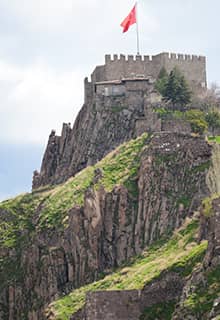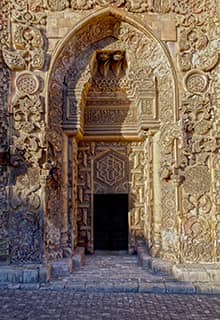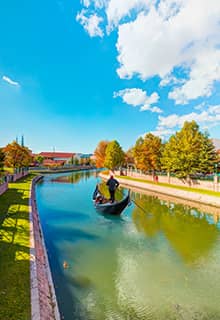

see
Central Türkiye
Anıtkabir (Atatürk’s Mausoleum) in Ankara
To the mind of many Ankara’s most important monument is the eternal resting place of Mustafa Kemal Atatürk, the founder of the modern Türkiye.
This mausoleum, built between 1944 and 1953, is a magnificent, neo-classical building appropriately designed with sombre lines and set on a vast esplanade. The entry to the mausoleum, known in Turkish as Anıtkabir, is provided through a triumphant alley lined with granite lions. It is a fitting monument to the greatness of the founder of modern Türkiye. There is a museum housing a wax statue of Atatürk, writings, letters and items belonging to him, as well as an exhibition of photographs recording important moments in his life and in the establishment of the Republic.
Göreme Open Air Museum in Cappadocia, Nevşehir
Visiting Göreme Open-Air Museum in Cappadocia is like entering into another world. There are many churches, chapels and living spaces carved into the rocks of this valley. This is where monastic life in the region began and the Christians who escaped oppression became missionaries and hermits. The Women’s and Men’s Monasteries, Elmalı (Apple) Church, Yılanlı (Snake) Church, Çarıklı (Sandal) Church, Dark Church, St. Barbara and St. Basil Churches and Tokalı (Buckle) Church will impress you with their unique frescoes and take you on a journey through history. This is the place that should be top of your list of places to visit. The Göreme Open-Air Museum has been listed amongst UNESCO’s World Heritage Sites List since December 1985.
Mevlana Museum and Mausoleum in Konya
As the capital of the Seljuk Turks from the 12th to the 13th centuries, Konya ranks as one of the great cultural centers of Türkiye. During that period of cultural, political, and religious growth, the mystic Mevlana Celaleddin-i Rumi founded a Sufi order known in the West as the Whirling Dervishes.
The striking, green-tiled mausoleum of Mevlana is Konya's most famous building. Attached to the mausoleum, the former dervish seminary now serves as a museum housing manuscript of Mevlana's works and various artefacts related to the mysticism of the sect.
Every year during the first half of December, Şeb-i Arus (Wedding Night) Ceremony held in commemoration of Mevlana Celaleddin-i Rumi, with the controlled, trance-like turning or sema of the white-robed men creating a fascinating performance for the viewer.
Divriği Ulu Mosque (Grand Mosque) in Sivas
Sivas is an important city of Central Türkiye and has always been a gateway from the east to Central Anatolia. Divriği, 150 km east of Sivas, is famous for its Ulu Mosque (Grand Mosque) Complex. The complex consists of a mosque and a hospital that is attached to it. An important detail is the use of shadows in the three-dimensional ornamentation of the two entrances of the mosque, which cast a giant shadow of a praying man that changes his pose as the sun moves. The interior of the mosque consists of stone piers which support the stone vaults. The hospital is entered through a portal located on the western façade. The interior of the hospital features rooms placed around a roofed courtyard with a small pool in the center. The whole complex was built in the 13th century, during the Seljuk period. The exquisite carvings and architecture of both buildings place them among the most important works of architecture in Anatolia. This complex has been listed amongst UNESCO’s World Heritage Sites List since 1985.
Odunpazarı District in Eskişehir
Odunpazarı is Eskişehir's first Turkish residential area. The earliest building in Odunpazarı, which contains the Turkish-Islamic culture and civil architecture examples in the city's past, is the Alaeddin Mosque, dating to the second half of the 13th century.
After the fires that broke out in the bazaar area of the city in 1905 and 1922, commercial and public buildings started to shift to Odunpazarı. Odunpazarı was sold in the area close to Yediler Park and this situation gave the district its name.
The historical Odunpazarı district has always been a very special geography with its houses that look like an oil painting, narrow streets, mosques, fountains, and small squares.
In addition to the historical houses in the region, there is also the Kurşunlu Mosque and its Complex, unique to the period which has expanded around the city. In addition, the historical Atlıhan, Eskişehir Arts Bazaars, where you can see examples of traditional handicrafts of the region, and the Meerschaum Museum, which is only in Odunpazarı, are among the places that should be visited.
Kültepe Archaeological Site in Kayseri
Kültepe is 21 km away from the centre of Kayseri. There were documents revealed, which date the area back to six thousand years. The Kültepe Archaeological Site (Kültepe Arkeolojik Alanı) is a tell, formed by the ruins of the first city founded by the Hittites in Anatolia and the Karum that surrounds it, where the remnants of administrative buildings, religious buildings, houses, shops, and workshops can be seen. The centre of the large trade colonies established by the Assyrians was Karum in Kültepe and ruled the other Karums. Kültepe stands out, as it hosts the first written tablets in Anatolia and is the first organized trade centre of the world. Written in Assyrian cuneiform, there are letters, bills, seals, and treaty texts showing the political and legal relations of the period. These tablets were added to the UNESCO Memory of the World Register List in 2015.
Neolithic Site of Çatalhöyük in Konya
Çatalhöyük is renowned as one of the earliest settlements of the Neolithic era, shedding light on the dawn of human settlement with unique examples of the earliest domestic architecture and landscape painting as well as sacred objects of the mother-goddess cult.
The place where the first known settlement, the first urbanization and the first animal domestication took place in the world is Neolithic Sites of Çatalhöyük. It is on the UNESCO World Heritage List since 2012.
The site has extraordinary arts and crafts, with the earliest finds dating from 7400 BCE, and it has been an important key to unlocking the mysteries of the beginnings of agriculture and civilization. The social organization of the Neolithic site of Çatalhöyük and its urban plan are believed to represent the ideals of equality.
The tumulus shows that the history of mining in Anatolia dates back to the Neolithic era and provides ample evidence that people were involved in agriculture as well as hunting and gathering at that time. Çatalhöyük is also the first site in the world where a city plan is depicted in wall paintings. Baked clay seals from the site show that the concept of property ownership developed in that era.
Hacı Bayram Mosque and Its Surrounding in Ankara
The Hacı Bayram Mosque is in the district located at the edge of the Ankara Citadel, in Ulus. The area where the Hacı Bayram Mosque and the Temple of Augustus are located has a traditional historical layout. It contains buildings from the Ottoman and Early Republican period, like the first parliament building of Türkiye dating back to 1923. The district is located on a hill which was a tumulus. The Hacı Bayram area was once the acropolis of ancient Ankyra, starting in the 8th century BCE, and throughout time it has been a sacred area where people of different faiths worshiped next to one another.
The Hacı Bayram Mosque, which was founded in the 15th century, is one of the most important mosques of Ankara. It was renovated in the 18th century, taking on characteristics of that period. Its most significant feature is that it was built without a dome but with a wooden ceiling covering the main interior space. The mosque was built by architect Mehmet Bey.
The Double Minaret Madrasa and Gök Madrasa in Sivas
The Double Minaret Madrasa was built in the late 13th century BCE. The only unique aspect of the building that has survived to the present day is its magnificent façade with the highest Crown gate in Anatolia. The two minarets rising above the Crown Gate have become the symbol of Sivas. It is one of the most monumental madrasas built in Anatolia and is also known as Dârü'l-hadis. It is a two-story building with four iwans.
Gök Madrasa, one of the most important buildings where Turkish architecture and decoration art can be observed in one place was built in 1271 in Sivas. The marble stone door of Gök Madrasa has a rich appearance that allows the light-shadow game to be experienced. The building has an open courtyard, four iwans, and a two-story plan. Gök Madrasa, especially with its monumental marble crown door and facade, fully reflects the character of the 13th century BCE. The main iwan, which should have been to the east of the madrasa, was destroyed, and was later built with lumber. The building, known to have served as a madrasa since its construction, was converted into a museum in 1926.
Çankırı Museum in Çankırı
The Museum initiated its activities in 1972 with the exhibition of archaeological and ethnographic artifacts and continued to serve in different buildings and locations over time. Today, the museum, which hosts visitors in the renovated old Government House, exhibits artifacts of the Bronze Age, Hittite, Phrygian, Hellenistic, Roman, Byzantine, Seljuk, and Ottoman Periods.
During scientific excavations carried out in late Miocene vertebrate fossil beds by the museum in cooperation with the Faculty of Language and History and Geography, in the University of Ankara since 1997, there were found 7-8 million years old fossils of the ancestors of elephants, rhinoceros, sheep, goats, pigs, giraffes, deer, and other primates. All finds are exhibited in the “Natural History” section.
















